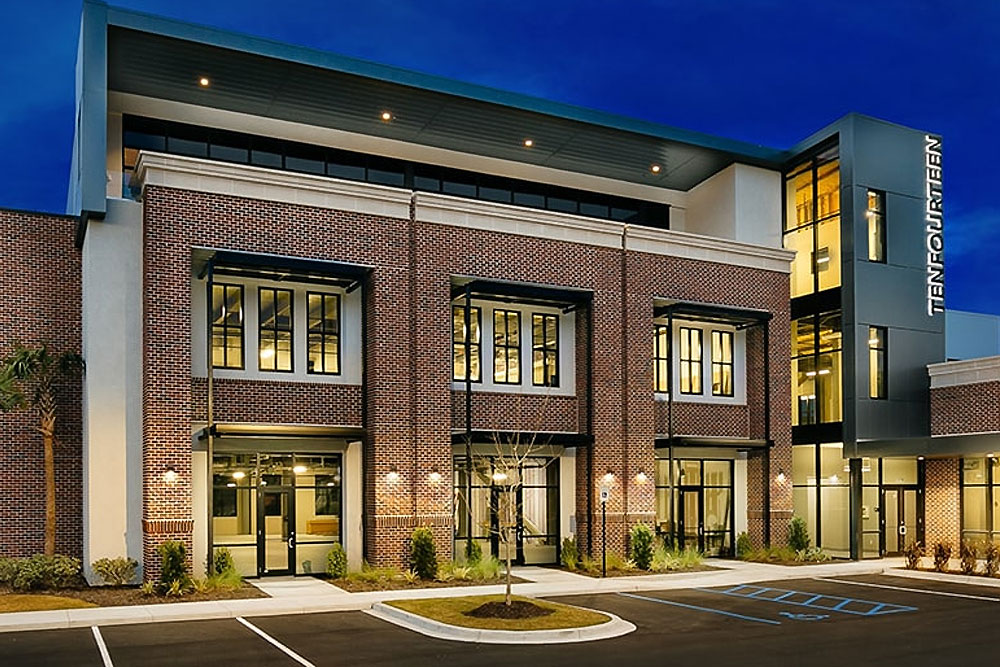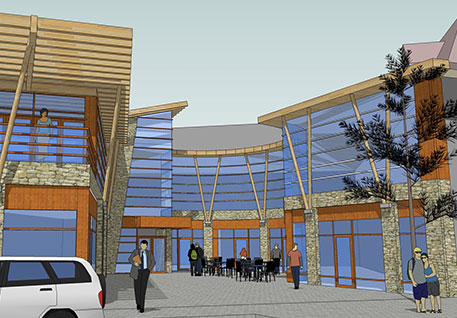Unveiling the Comprehensive Services Offered by Commercial Architects for Modern Developments
Commercial Architects serve a crucial function in contemporary development jobs. They mix style appearances with functionality while adhering to regulatory demands. Their experience expands beyond simple building, incorporating lasting methods and innovative innovations. As they navigate complicated zoning laws, Architects collaborate with numerous stakeholders to bring visions to life. This diverse strategy increases questions about the evolving duty of Architects in shaping modern-day areas and the effect of their deal with future developments.
Understanding the Role of Commercial Architects in Modern Advancement
In modern city landscapes, Commercial Architects play an important role in shaping useful and aesthetic spaces that satisfy diverse business needs. Their experience extends beyond simple design; they navigate complicated zoning legislations, constructing codes, and environmental regulations. By collaborating with customers, they determine specific needs, ensuring that each task lines up with the client's vision while additionally thinking about practical facets such as sustainability and cost-effectiveness. Commercial Architects are adept at incorporating cutting-edge innovations and materials into their layouts, boosting both the capability and power performance of structures. They perform comprehensive website analyses to evaluate the prospective challenges and chances offered by an area. Additionally, effective communication with contractors and various other stakeholders is vital, guaranteeing that the job proceeds smoothly from conception to completion. Inevitably, Commercial Architects are important in producing areas that not only meet sensible purposes yet additionally add to the overall personality and vibrancy of urban settings.
Concept Design: Changing Ideas Into Fact
Principle design works as a necessary phase in Commercial design, where cutting-edge style options emerge from innovative brainstorming. This process counts on collective ideation, bringing together varied point of views to fine-tune and enhance preliminary concepts. As ideas form, they transform from abstract concepts into substantial building truths.
Innovative Design Solutions
Transforming concepts right into fact is the trademark of innovative style solutions in Commercial style. These remedies mix creative thinking with performance, attending to the distinct requirements of modern growths. By leveraging innovative modern technologies and lasting practices, Architects craft areas that are not only aesthetically enticing but also effective and adaptable. Focus on individual experience drives the layout procedure, making sure that settings foster performance and cooperation. Each task gain from a tailored approach, where principles are carefully established to reflect the customer's vision while taking into consideration future fads. Ingenious layout services also focus on flexibility, permitting for alterations in time as business needs progress. Eventually, these approaches boost the general value of Commercial spaces, making them pivotal in today's affordable landscape.

Joint Ideation Refine
Collaboration works as the backbone of the ideation process in Commercial design, cultivating imagination and development among diverse stakeholders. Architects, clients, engineers, and community members participate in dynamic discussions, making certain that all perspectives are considered. This comprehensive approach permits the exploration of numerous layout principles, urging unique solutions that line up with the project's vision. Via workshops and brainstorming sessions, concepts evolve and fine-tune, transforming preliminary principles into substantial designs. Technology also plays a critical function, with tools such as Building Details Modeling (BIM) helping with real-time collaboration and adjustments. Inevitably, this collective ideation procedure not only boosts the layout outcome but likewise cultivates a feeling of possession and investment amongst all events entailed, resulting in effective Commercial growths.
Zoning Analysis: Browsing Regulations and Compliance
As designers commence on new jobs, comprehending zoning policies is crucial to ensuring conformity and staying clear of expensive hold-ups. Zoning evaluation plays a crucial function in this procedure, as it includes reviewing neighborhood zoning regulations that dictate land usage, developing elevation, density, and problems. Commercial Architects possess the knowledge to navigate these complex guidelines, assisting customers determine acceptable uses and any essential variations.
Lasting Style Practices: Structure for the Future
Sustainable design practices are increasingly crucial in the domain name of Commercial design, especially as ecological concerns remain to escalate. Architects focus on environmentally friendly materials, energy-efficient systems, and layout approaches that lessen waste and environmental effect. Incorporating eco-friendly power sources, such as photovoltaic panels and wind turbines, allows structures to generate their own power and reduce reliance on fossil fuels.Furthermore, lasting design stresses the importance of indoor ecological top quality. This includes using all-natural light, improving ventilation, and picking non-toxic materials to boost owner wellness and efficiency. Eco-friendly roofing systems and living wall surfaces are additionally prominent functions that add to biodiversity and urban cooling.Additionally, Commercial Architects frequently integrate water conservation techniques, like rainwater harvesting and drought-resistant landscape design. Through these ingenious approaches, they produce areas that not only satisfy modern needs but likewise promote a lasting future, dealing with the growing need for accountable growth in the modern-day world.
Project Monitoring: Ensuring Timely and Effective Execution
Effective project administration is important for ensuring that Commercial design jobs are completed on schedule and within spending plan. This function incorporates an array of responsibilities, including the sychronisation of various stakeholders, timelines, and resources. Commercial Architects leverage their expertise to produce thorough job plans that detail vital turning points and deliverables, enabling methodical progression tracking.Regular communication among employee and clients is important, promoting transparency and assisting in prompt decision-making. Danger administration strategies are also utilized to identify possible challenges early, allowing proactive services to be developed. By making use of sophisticated project administration devices, Architects can keep an eye on project efficiency in real-time, making changes as needed to keep performance.
Inside Design: Producing Functional and Visual Areas
Interior decoration plays a crucial role in enhancing both functionality and appearance within Commercial spaces. Reliable space planning can enhance process and boost individual experience, while visual layout principles contribute to a visually attractive atmosphere - commercial architects. With each other, these components produce spaces that are not only practical yet also motivating
Room Preparation Efficiency
While making best use of the utility of readily available room, Commercial Architects prioritize room preparation effectiveness to produce both useful and cosmetically pleasing settings. This technique involves careful analysis of the spatial design to assure perfect use every square foot. get more Architects take into consideration aspects such as process, access, and natural light to improve functionality. By purposefully positioning furniture, equipment, and workstations, they help with activity and communication amongst users, advertising efficiency. In addition, zoning different locations for details features aids in handling sound and privacy, creating a harmonious atmosphere. Via effective area preparation, Commercial Architects can transform restraints right into chances, guaranteeing that each area meets the varied requirements of its residents while adhering to regulative demands and market requirements.
Visual Style Principles
Aesthetic design principles play an essential role in shaping environments that are not just useful but also visually enticing. These concepts assist Commercial Architects in developing spaces that reverberate with users while boosting brand name identification. Trick aspects include balance, proportion, and consistency, which interact to develop a cohesive appearance. Color design and materials are thoroughly picked to stimulate wanted feelings and support the total theme. Furthermore, lighting plays a critical function, influencing state of mind and visibility while highlighting architectural functions. By integrating these concepts, Architects guarantee that rooms are not just functional but likewise inviting and inspiring. Ultimately, efficient visual style fosters a positive individual experience, motivating engagement and complete satisfaction in Commercial environments.
Partnership With Stakeholders: Fostering Successful Partnerships
Effective collaborations in Commercial design joint on effective cooperation with stakeholders, making certain that every voice is heard and valued. This joint strategy involves interesting different events, including clients, specialists, and community members, throughout the style and advancement procedure. By cultivating open communication, Commercial Architects can attend to problems, collect understandings, and line up the task's vision with stakeholder expectations.The assimilation of varied viewpoints improves imagination and technology, leading to even more functional and visually pleasing styles. Normal conferences, responses sessions, and workshops facilitate this dialogue, allowing Architects to adjust their plans in feedback to stakeholder input. In enhancement, developing trust with openness and responsibility strengthens these collaborations, leading to a smoother task execution.Ultimately, the success of modern-day growths relies on the Architects' ability to navigate and integrate varying interests, producing a collective setting that promotes shared goals and mutual success.
Regularly Asked Concerns
Just How Do Commercial Architects Manage Spending Plan Constraints Throughout a Project?

What Kinds of Software Program Do Commercial Architects Frequently Utilize?
Commercial Architects generally use software program such as AutoCAD for preparing, Revit for Structure Information Modeling, SketchUp for 3D modeling, and task management devices like Microsoft Job to enhance partnership and simplify operations throughout the style process.
Can Commercial Architects Help With Acquiring Funding for Projects?
Commercial Architects can aid in acquiring financing for jobs by preparing thorough proposals, helping to articulate design visions, and supplying economic forecasts that can enhance the likelihood of protecting necessary funding from capitalists or banks.
Just How Do Architects Guarantee Security During the Construction Process?
Architects assure security throughout building the original source and construction by implementing rigorous layout requirements, collaborating with designers, carrying out regular website assessments, adhering to regional policies, and promoting interaction amongst all stakeholders to reduce dangers and advertise a safe working setting.
What Ongoing Support Do Architects Supply After Job Conclusion?
After job conclusion, Architects supply ongoing support through upkeep appointments, efficiency analyses, and design adjustments. They guarantee buildings fulfill progressing needs, address possible problems, and maintain compliance with guidelines, cultivating right here a long-term connection with customers.